What Cut of Beef is Best for Stir-fry?
Chinese restaurants use flank steak, by far the most popular meat cut, in all of their stir-fry dishes. Additionally, it is the beef cut that we use in our stir-fry recipes that is most frequently advised.
Flank steak is flavorful, relatively reasonably priced, and readily available. To create a fantastic stir-fry, all you need to do is ensure that the meat is properly sliced and marinated.
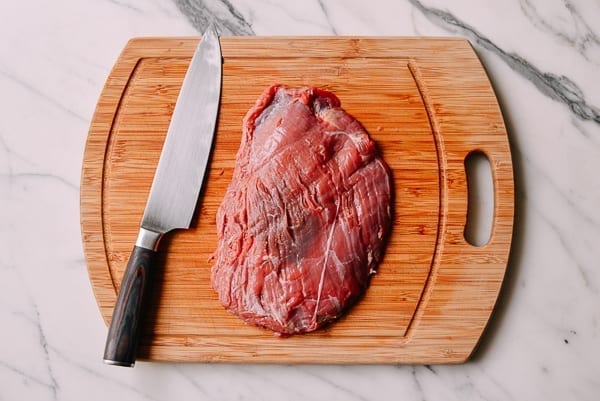
For beef stir fries, boneless beef chuck steak is a more affordable option. Due to the additional fat that comes with this cut of meat, we prefer using beef chuck steak for stewing and braising, but it can also be used in stir-fries.
Chuck steak is also more economical than flank steak. You can purchase a big piece, slice it up, portion it out for a few stir-fries, and freeze it!
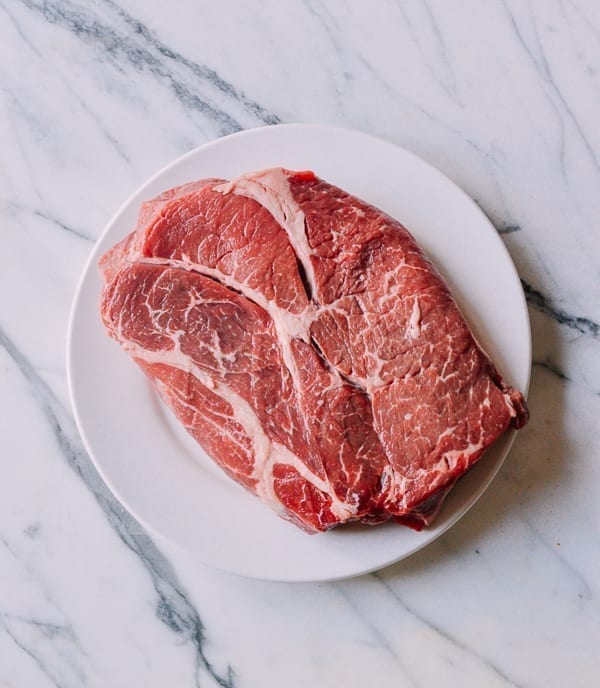
The beef chuck steak needs a little more trimming and attention when being prepared for stir-frying. To obtain some neat beef chunks for slicing, slice the beef along the fat lines and remove the thick membrane. Use a good chef’s knife, and as always, exercise caution when using pointed objects.

How to Cut Beef For Stir-fry
Trim any white muscle membranes from your flank steak if you’re using it, then cut it into 2 to 2 1/2-inch strips by cutting it lengthwise against the grain.
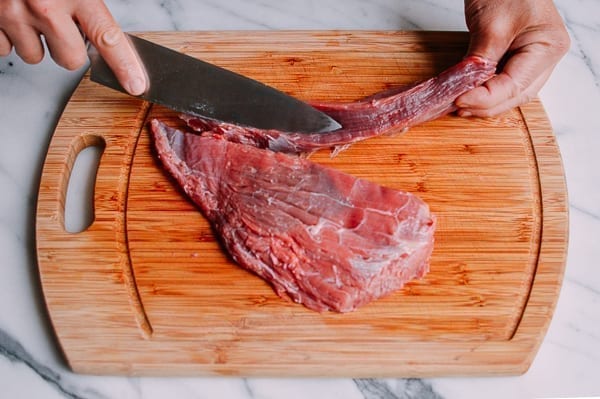
The flank steak’s long grains of muscle fiber are simple to spot. Slice the flank steak against the grain (perpendicular to the long muscle lines) to create small pieces.
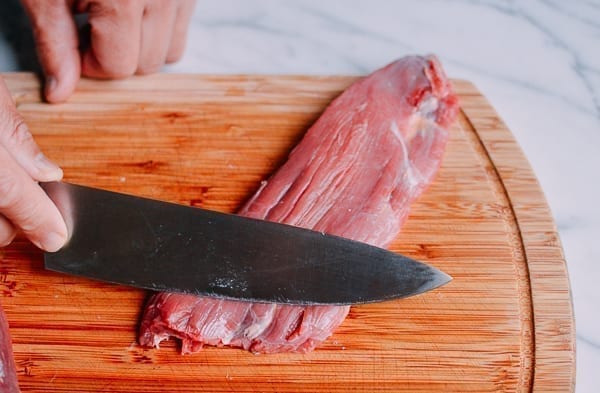
Slice the meat 1/4″ thick for tender, bite-sized pieces. Additionally, the slices become wider and thicker when the knife is held at a 45° angle.
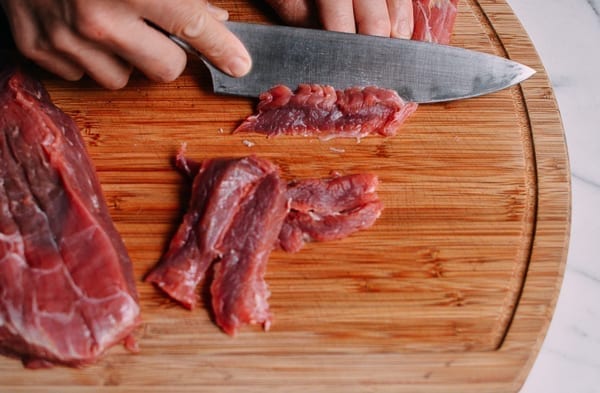
Now your beef is ready for marinating!
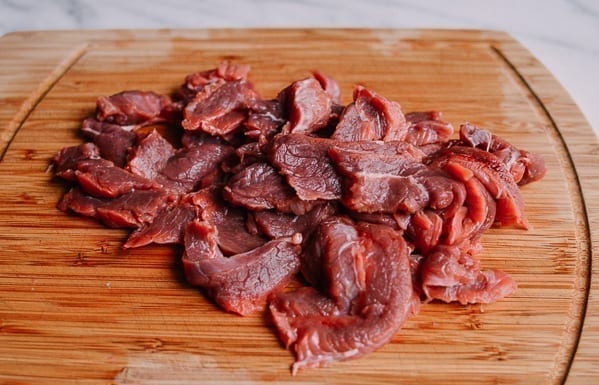
If you’re using boneless beef chuck, see our slicing instructions below. If not, skip down to the next section.
Cutting Boneless Beef Chuck for Stir-fry
It’s crucial to cut meat against the grain to produce nice, tender pieces for your stir-fry dishes.
Once more, the long muscle fibers running parallel to one another through the beef are referred to as the “grain.” Cutting across those strands is equivalent to cutting against the grain, which shortens the long muscle fibers to produce small, tender pieces.
Compared to flank steak, identifying the direction of the grain in beef chuck is much more difficult. This image demonstrates the vertical grain pattern of the meat and fat.
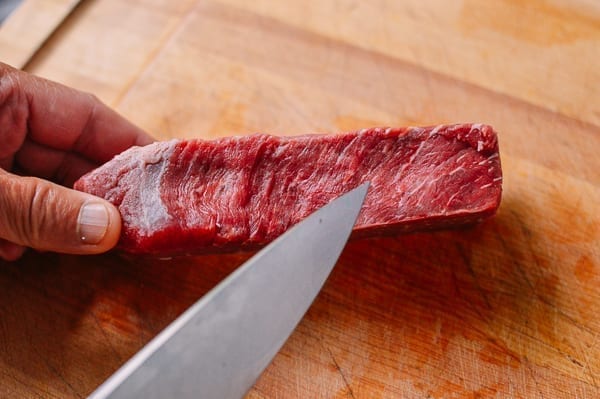
For this piece, we must first cut the long strip into 2-inch wide chunks because we must cut against the grain.
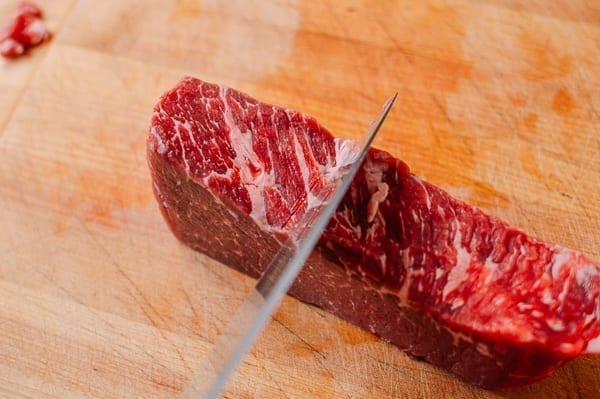
Position each piece before cutting it so that the long fibers are shortened.
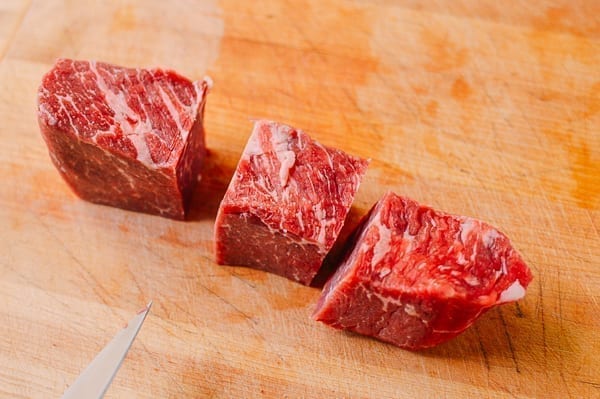
Look at how the knife is set up to cut the beef against the grain.
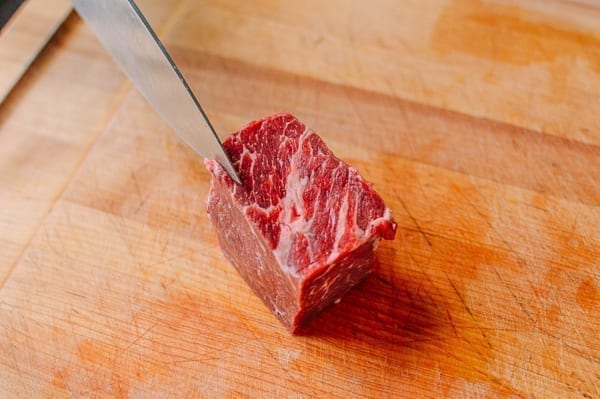
Now, cut your beef into 1/4″ thick slices…
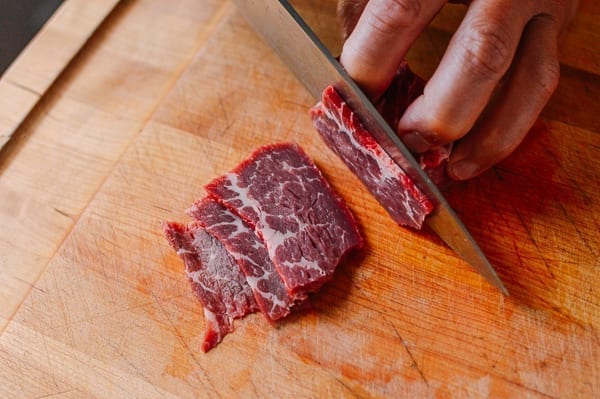
In this picture, you can see the grain and the slice a little bit more clearly, but you can see how the soft beef might be challenging to handle and slice.
A chef’s trick for quickly slicing beef is to partially freeze it for 30 to 60 minutes until firm.
Due to the firm beef not sliding under your knife and around the cutting board, slicing is much simpler and quicker. Meat that has partially frozen also makes it easier to cut precisely to the desired thickness.
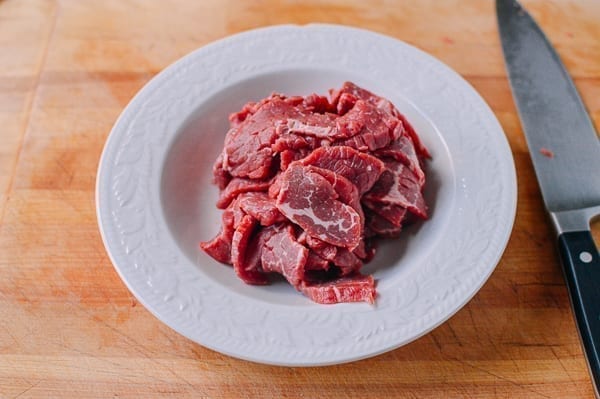
How to Cut Beef for Lo Mein & Other Noodle Dishes
When using beef in dishes like Beef and Pepper Stir Fry or noodles, it is necessary to take additional steps to julienne (thinly slice) the beef.
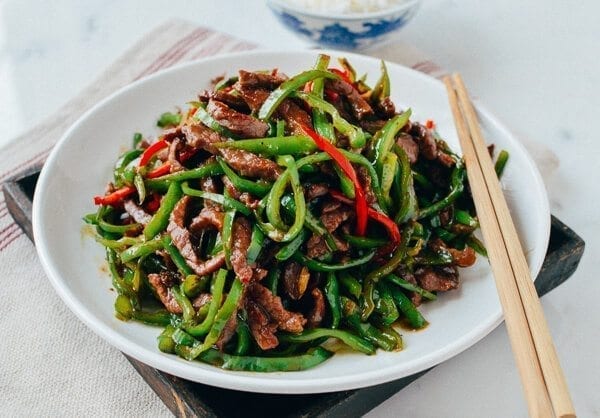
The manner in which ingredients are cut should be uniform in Chinese stir-fry cooking. For stir-fries with vegetables like beef and broccoli or beef and tofu, rectangular slices of beef are used. Long, thin strips of beef must be cut in order to make the long, stranded noodles found in Beef Lo Mein.
Small meat pieces are necessary in beef fried rice to complement the tiny rice grains. Make sense?.
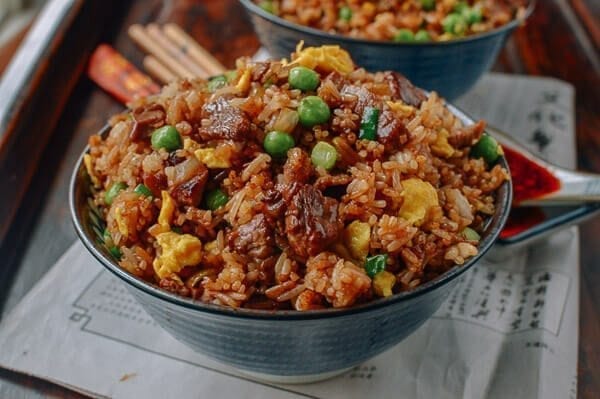
How Chinese Restaurants Tenderize Beef
It’s time to divulge some insider tips from Chinese restaurants on how to tenderize beef. The traditional Chinese method of velveting beef involves tenderizing your beef as the first step.
The first step is to liberally sprinkle the beef with baking soda, about 1 level teaspoon per pound (450g).
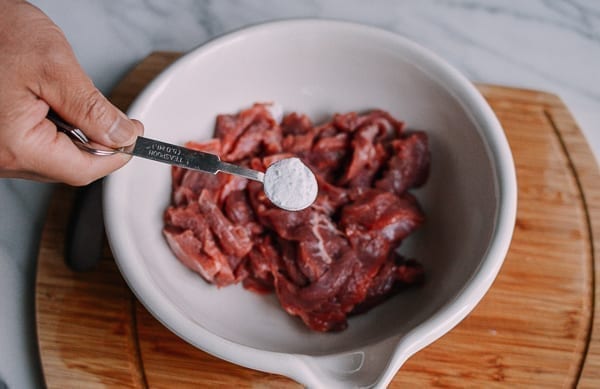
After that, add 1/4 cup (60 ml) water (per pound of beef) and massage the beef to evenly distribute the water and baking soda. Set aside for 1-2 hours. This step tenderizes (baking soda) and hydrates (water) the beef.
The beef must then be thoroughly rinsed under running water to remove any remaining baking soda, otherwise the dish will taste like baking soda.
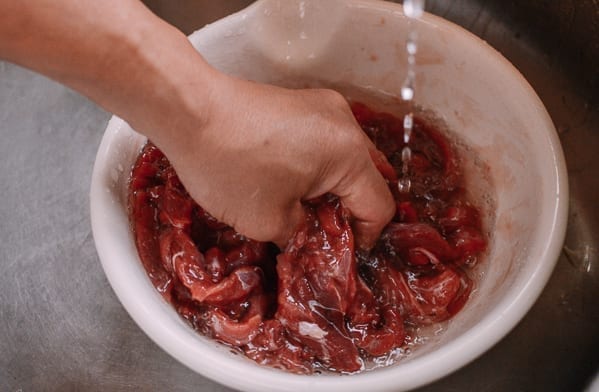
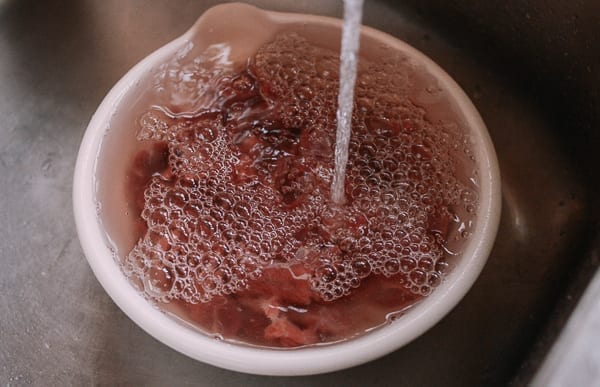
During the rinsing process, stir the beef with your hands.
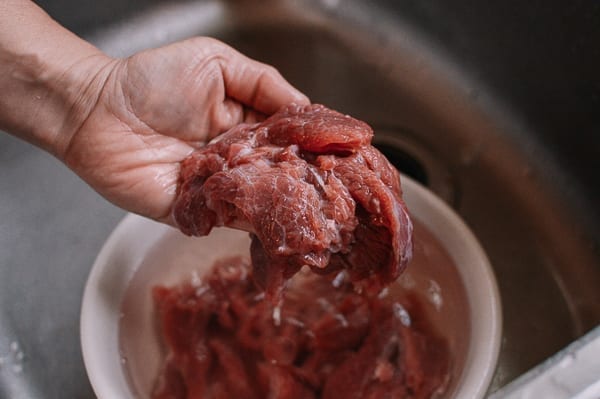
Drain the beef completely in a colander once the water is clear, then transfer it to a bowl for marinating (more information in the section after this).
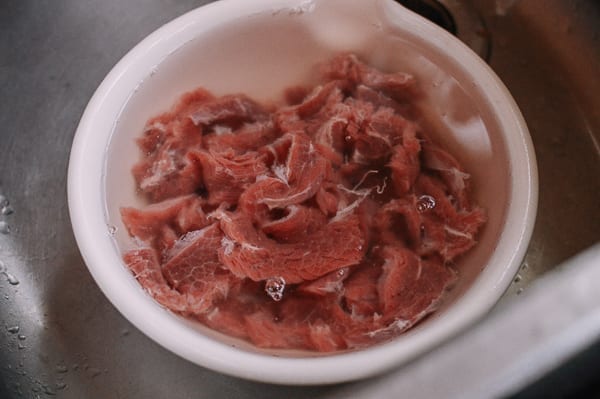
Shortcut to Tenderizing Beef at Home
If the above-described method of beef tenderization used by Chinese restaurants sounds a bit tedious, there is another method you can use.
Although baking soda is a potent tenderizer, too much of it can give the beef a bad taste, so it is rinsed off.
Reduce the amount of baking soda and lengthen the marinating period as a fix. Depending on how tough the cut is, add 1/8 to 1/4 teaspoon of baking soda and 2 to 3 tablespoons of water per pound of beef. Mix and work it into the meat before marinating. This will also do a fine job tenderizing!.
Your beef should be marinated for at least 15 minutes longer.
Adding water to the beef is optional, as well, I will add. For some stir-fry dishes, I believe there are benefits to using both moist hydrated beef and a drier beef.
How to Marinate Beef for Stir-fry
The crucial second step of velveting beef, which you should never skip, is to marinate it. Contrary to what you may be accustomed to, the marinade does not consist primarily of submerging the beef in a variety of liquids or seasonings.
It’s about giving the beef an extra juicy texture. Have you ever attempted to prepare a stir-fry at home, only to have the meat turn out dry and completely different from what you’ve had in Asian restaurants?
If you master this marinating method, you can make Chinese stir-fry dishes at home.
After the beef has been tenderized:
- To add even more flavor to your beef, add soy sauce and/or oyster sauce. Add about 2 teaspoons of each per pound of beef.
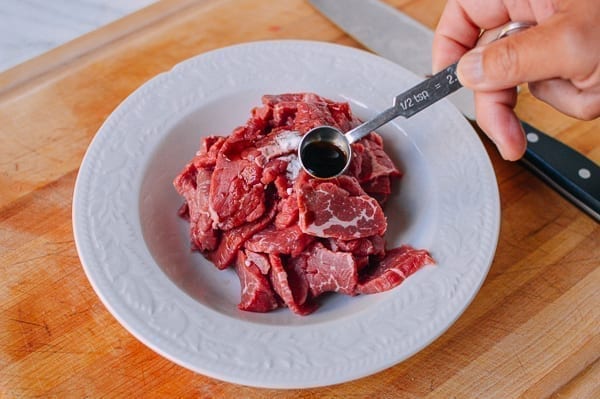
2. Add oil and cornstarch to the meat to create a velvety texture. Add about 2 teaspoons of each per pound of beef.
The beef has a velvety smooth texture thanks to the cornstarch and oil, which also safeguard the meat during cooking.
For flavor, you can also add Shaoxing wine (2 teaspoons per pound), but it’s completely optional for those of you who don’t want to drink alcohol.
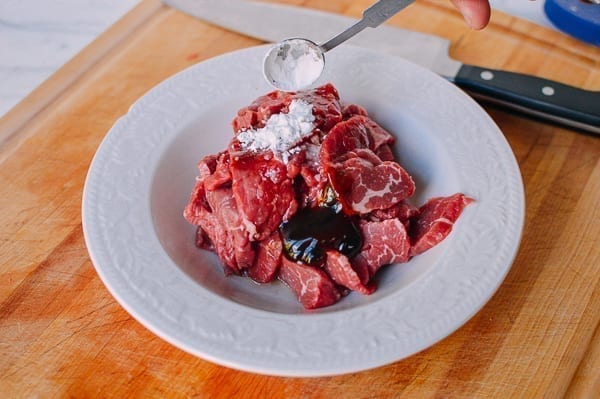
3. While you prepare the other ingredients, combine everything and set it aside to marinate for 15 to 30 minutes.
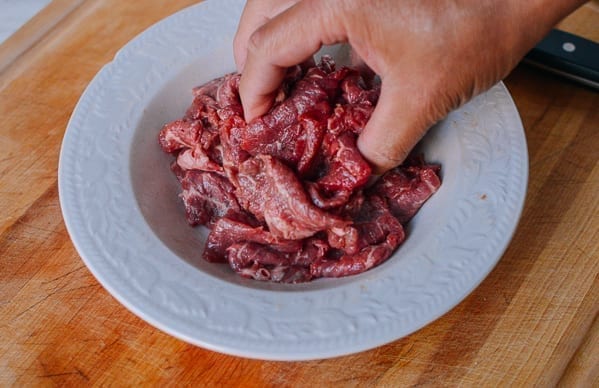
What is Chinese Velveting?
Traditional Chinese cooking calls for the process of “velveting” to prepare meats for stir-frying. Chinese velveting methods include tenderizing, marinating, and various cooking techniques, depending on the cut and type of meat used for the dish.
Velveting preserves meat’s moisture and gives it a soft, velvety texture that is a defining characteristic of Chinese cuisine.
How to Velvet Beef for Stir-Fry
The process of tenderizing beef and then marinating it in seasonings, oil, and cornstarch is the first step in velveting beef.
Any beef that has been tenderized will be soft and juicy, and beef that has been marinated will have a more savory umami flavor and a velvety coating. Pictured below is the marinated beef before cooking.
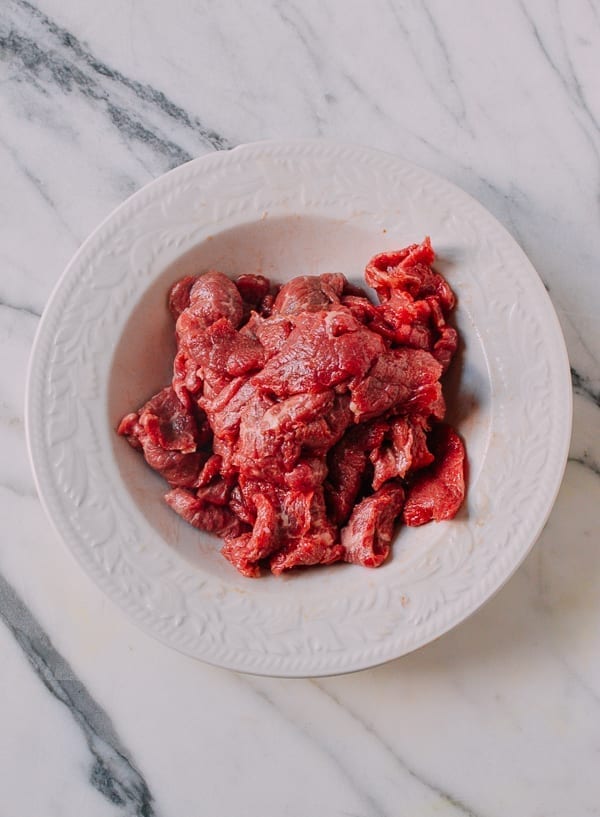
Pre-cooking is the final step in the velveting process, and it really depends on the dish you’re making and the result you want.
Traditionally, beef is velveted by passing it through hot oil (basically deep frying), a process known as “zu yóu” () in Mandarin or “jau yau” () in Cantonese.
Most of the time, we prefer to sear the meat in a hot wok because it is simply not practical to keep a wok full of oil at home. Having said that, we believe searing beef adds more flavor than jau yau deep-frying.
Some recipes, such as soups, only call for the final step of cooking the beef in water.
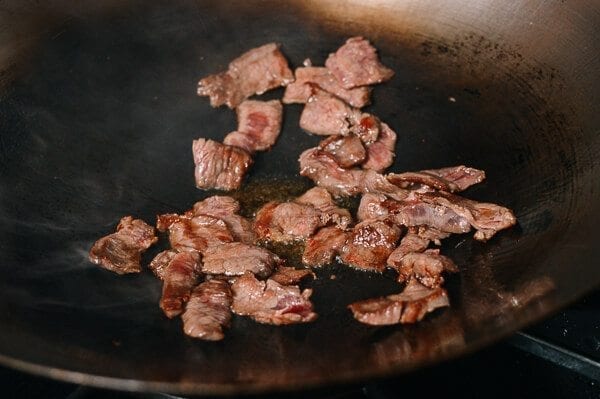
And if you have any questions, let us know in the comments!
Looking for more authentic recipes? Subscribe to our email list and be sure to follow us on Pinterest, Facebook, Instagram, and Youtube!
How to Prepare Beef for Stir-fry

- 1 pound of chuck or flank steak made from beef (450g, cut against the grain)
- ▢ 1 teaspoon baking soda
- ▢ water 1/4 cup (60 ml) per pound
- ▢ 2 teaspoons vegetable oil
- ▢ 2 teaspoons oyster sauce or soy sauce
- ▢ 2 teaspoons cornstarch
- ▢ 2 teaspoons Shaoxing Wine (Optional)
- Sliced beef is mixed with baking soda and water, then is given a hand massage until the majority of the liquid is absorbed. Let stand 1-2 hours.
- Thoroughly rinse the beef in running water until the water is clear. Drain.
- To the beef, add oil, oyster or soy sauce, Shaoxing wine (optional), and cornstarch. After 15 to 30 minutes of marinating, your beef is ready to use.
TheWoksofLife. com is written and produced for informational purposes only. Although we try our best to provide nutritional information to our readers as a general guide, the values provided should be regarded as estimates since we are not certified nutritionists. brands that were purchased, naturally occurring variations in fresh ingredients, etc. will change the nutritional information in any recipe. Additionally, depending on their sources, different online calculators produce various results. Utilize your preferred nutrition calculator to calculate the nutritional information for a recipe using the actual ingredients and quantities used.
How to slice beef for stir fry
FAQ
What are the best cheap beef cuts for stir-fry?
Sirloin tip steak is a superstar in the world of “low-cost cooking” because it is boneless and lean. The Sirloin Tip Roast is excellent for cubed steak, kabobs, stew meat, and stir-fry strips.
What makes Chinese beef so tender?
Chinese cuisine calls for velveting meats like beef, pork, or chicken before stir-frying them. Velvet can be made in a number of ways, but the most fundamental one is by marinating meat with at least one ingredient that will make it alkaline. This is what tenderizes the meat, especially cheaper, tougher cuts.
Is sirloin steak good for stir-fry?
Our preferred cut of beef for stir-frying is top sirloin because it is reasonably priced and yields juicy results. The best beef cuts for stir-fries are typically the following: top sirloin steak (or standard).
What is a good substitute for flank steak in stir-fry?
Many recipes, including stir-fries, fajitas, sandwiches, and salad toppings, work well with flat iron steak in place of flank steak. Despite being fattier, it has a similar beefy flavor to flank steak and gives dishes more richness. This steak cut is much more tender than flank steak.
